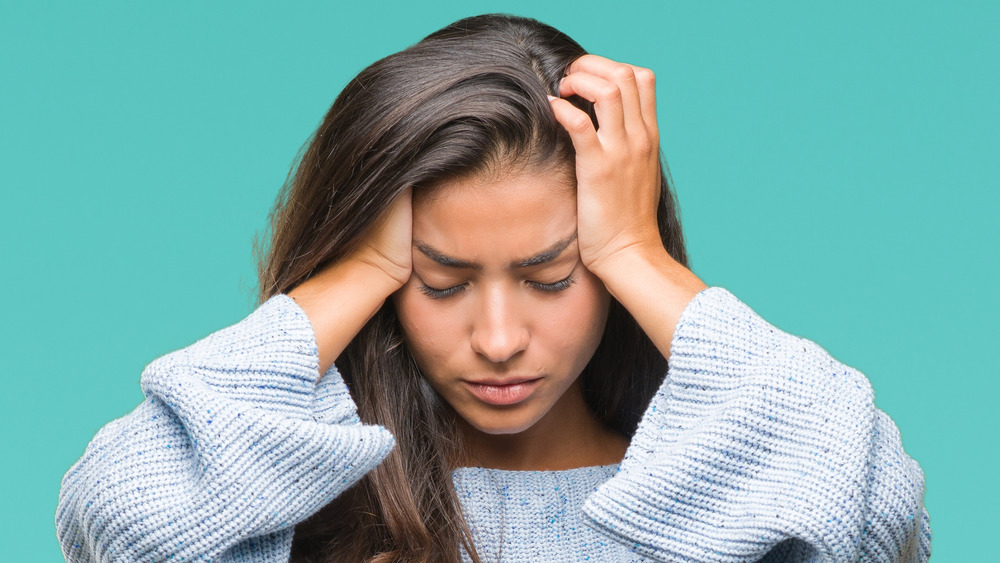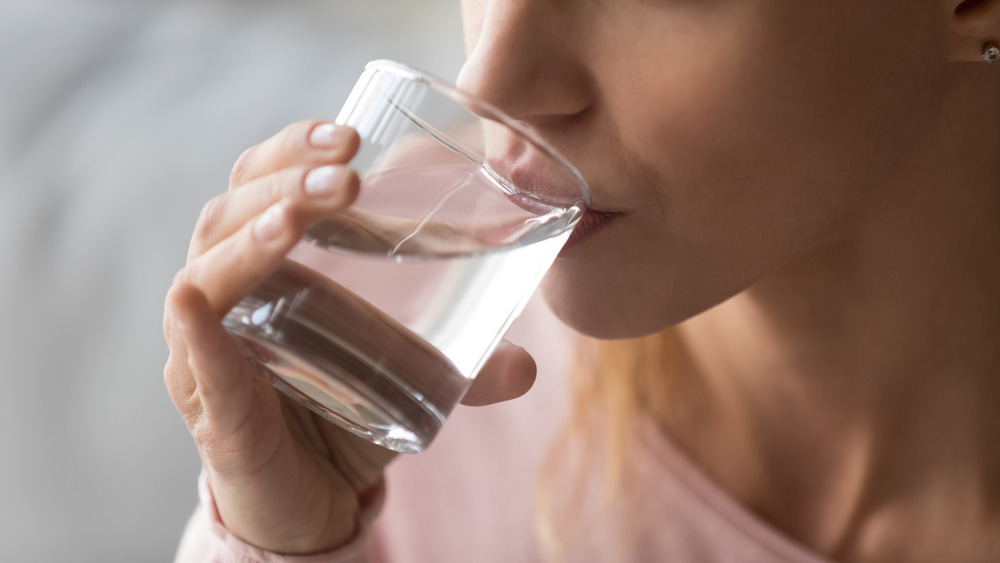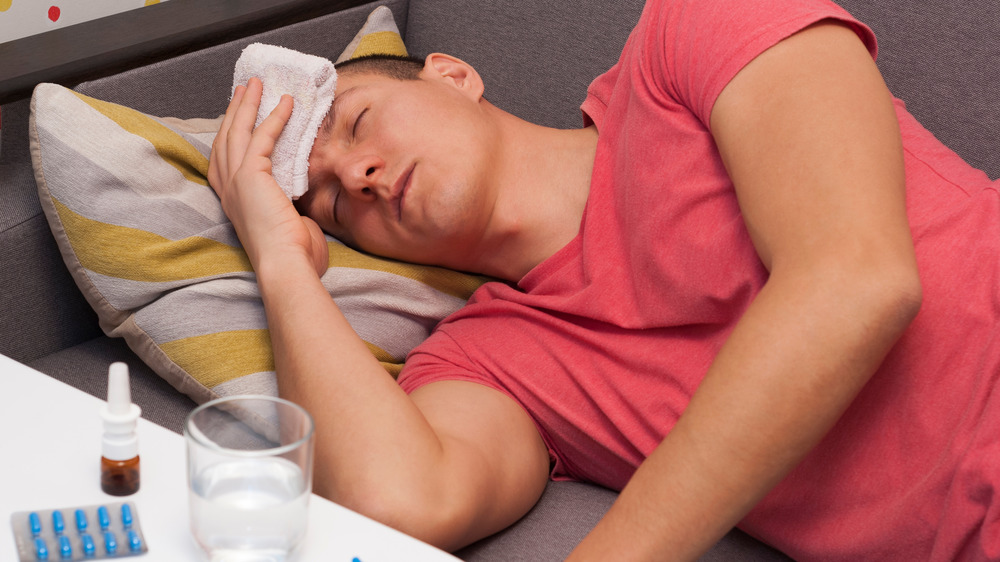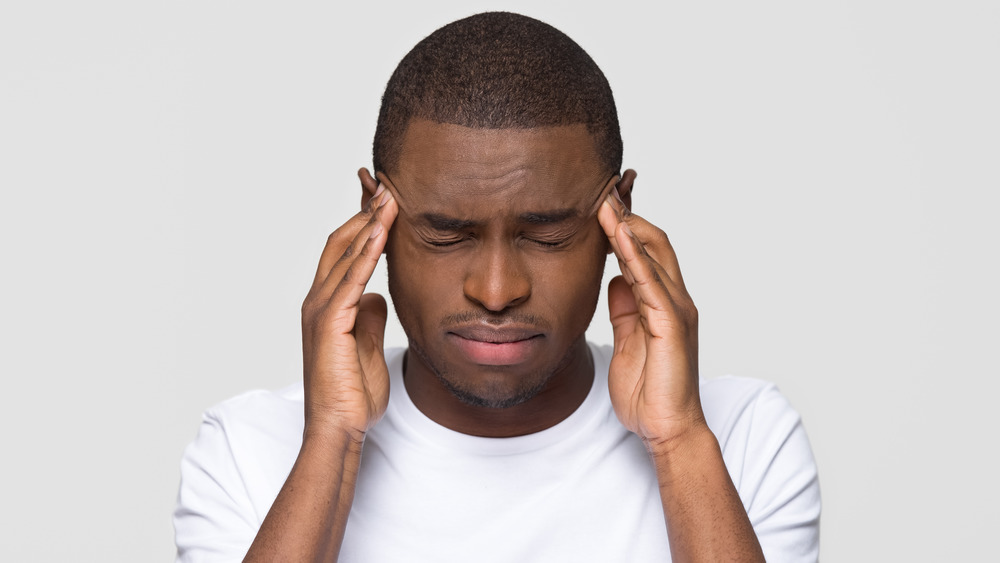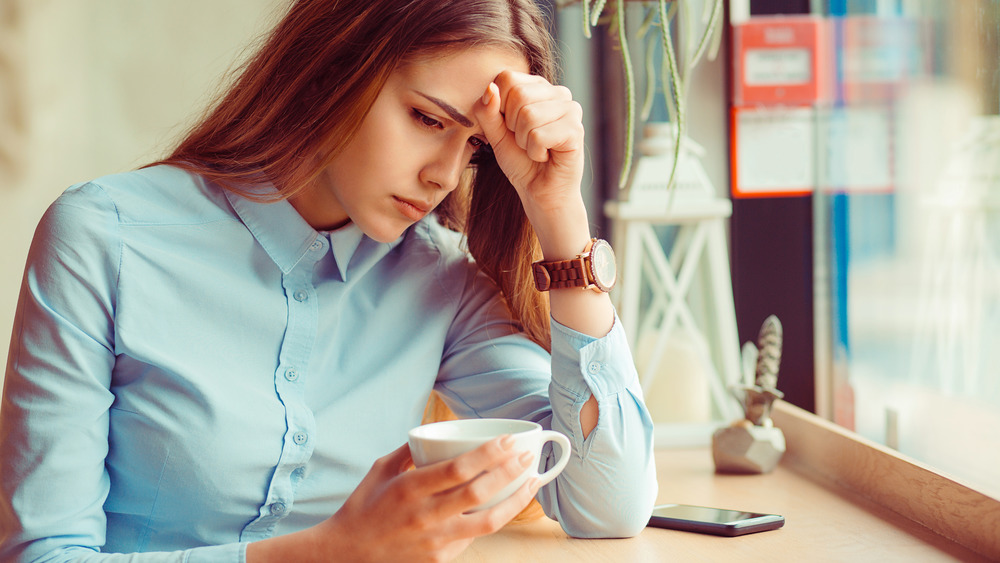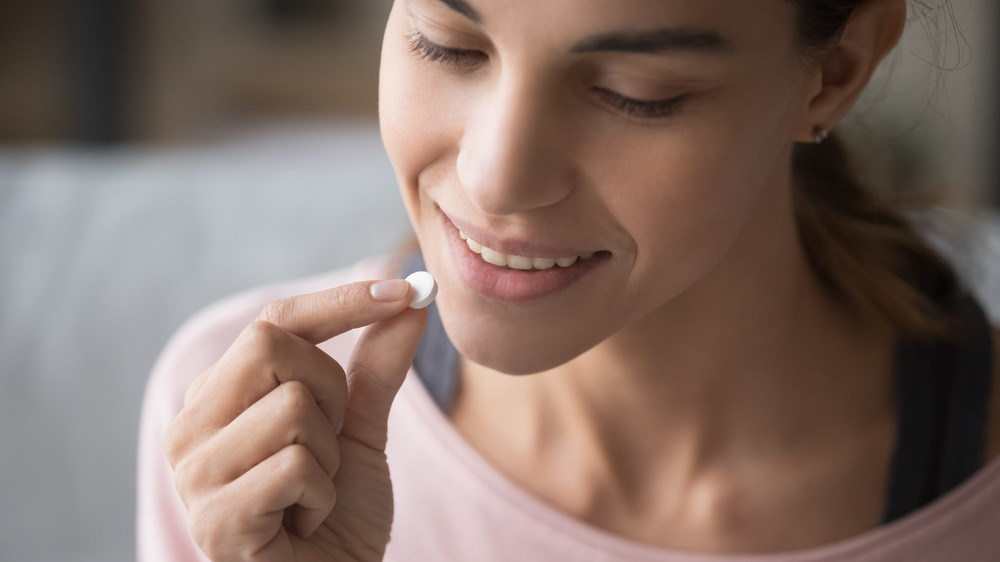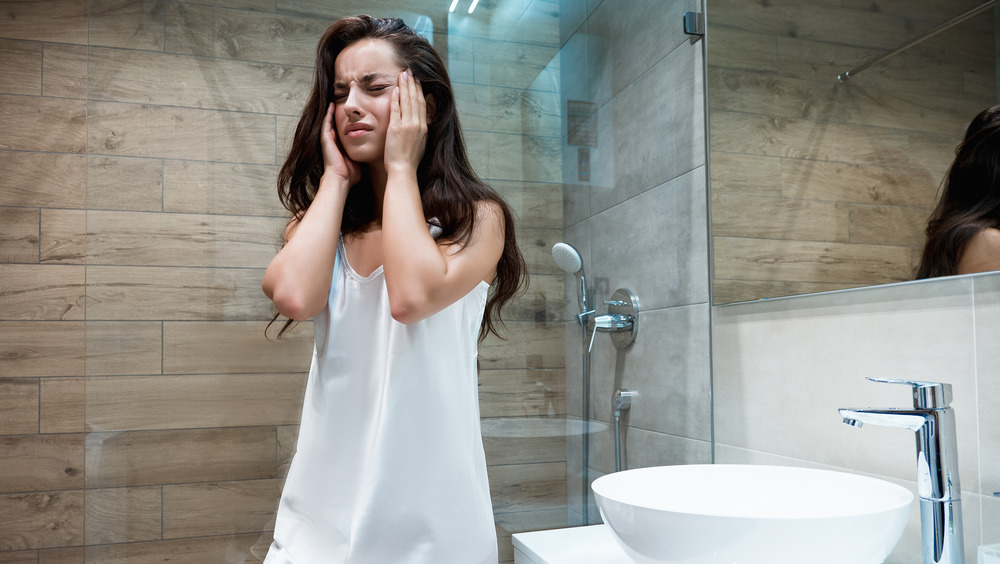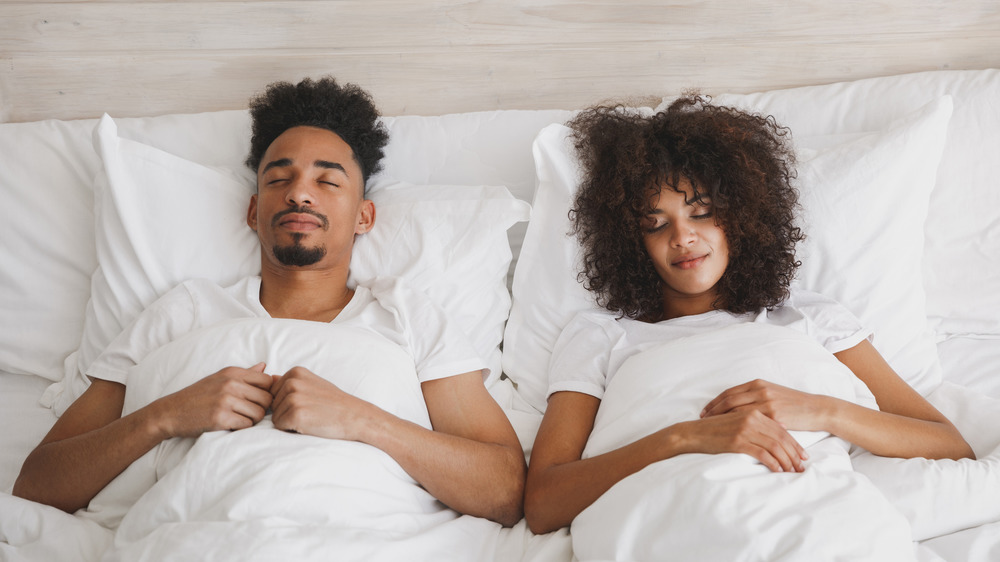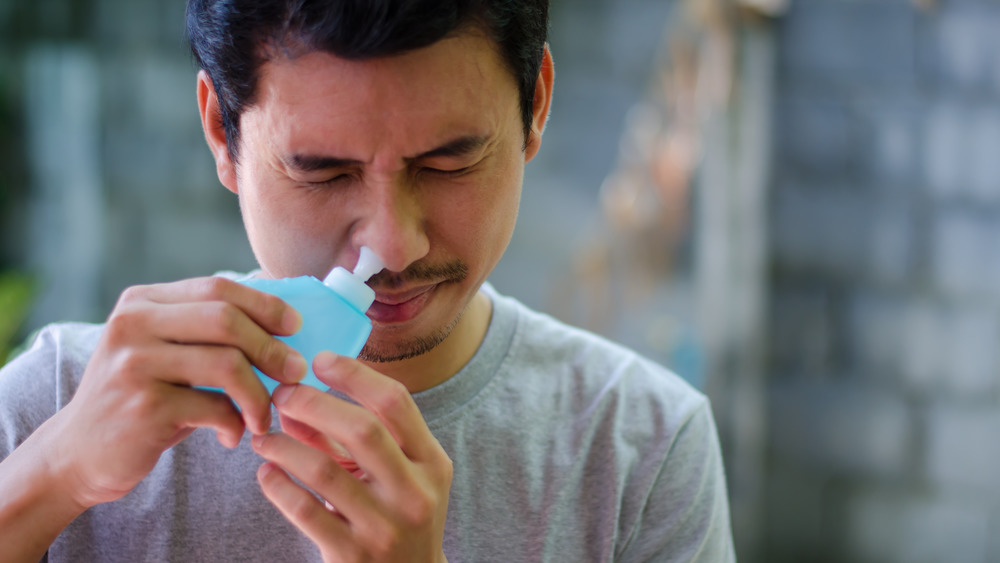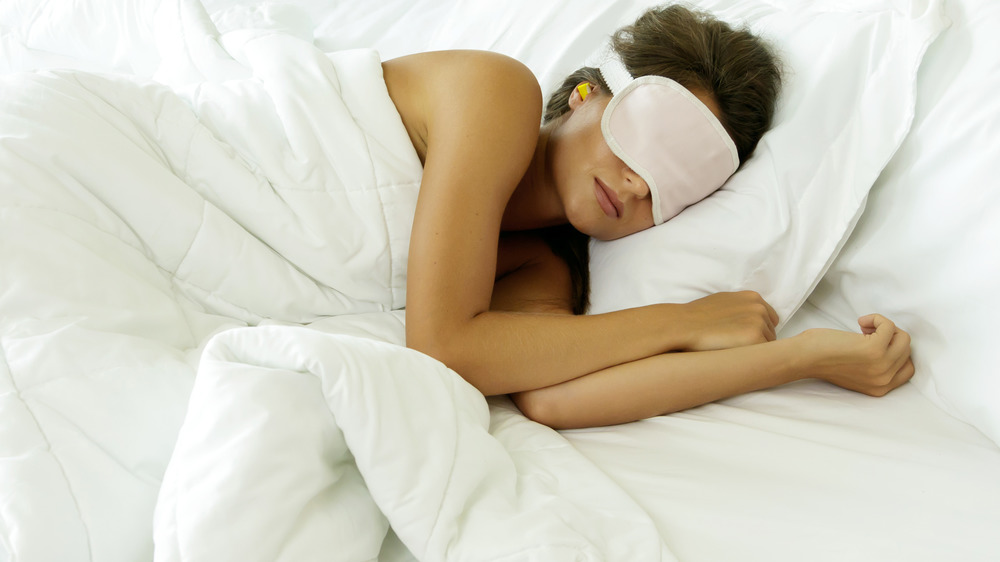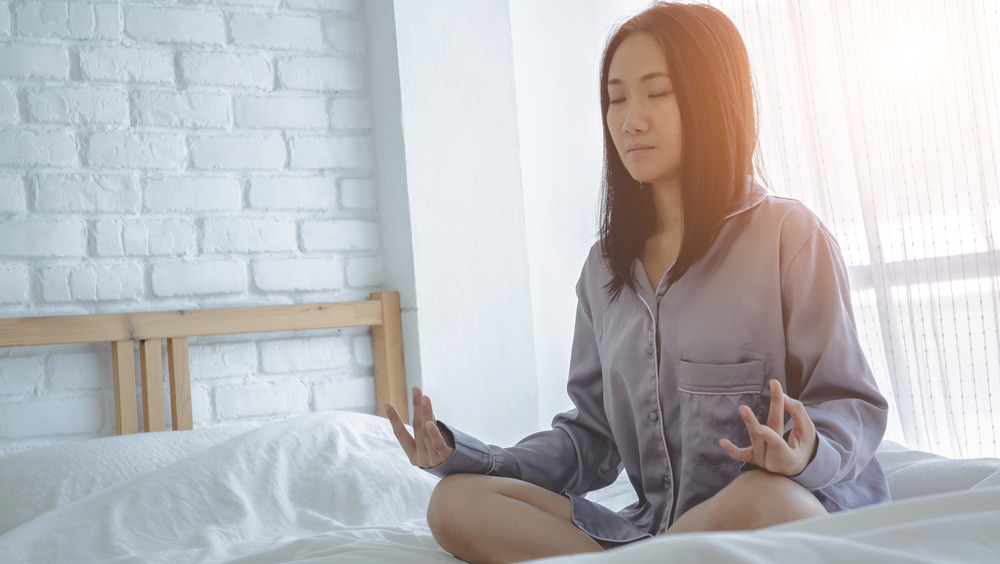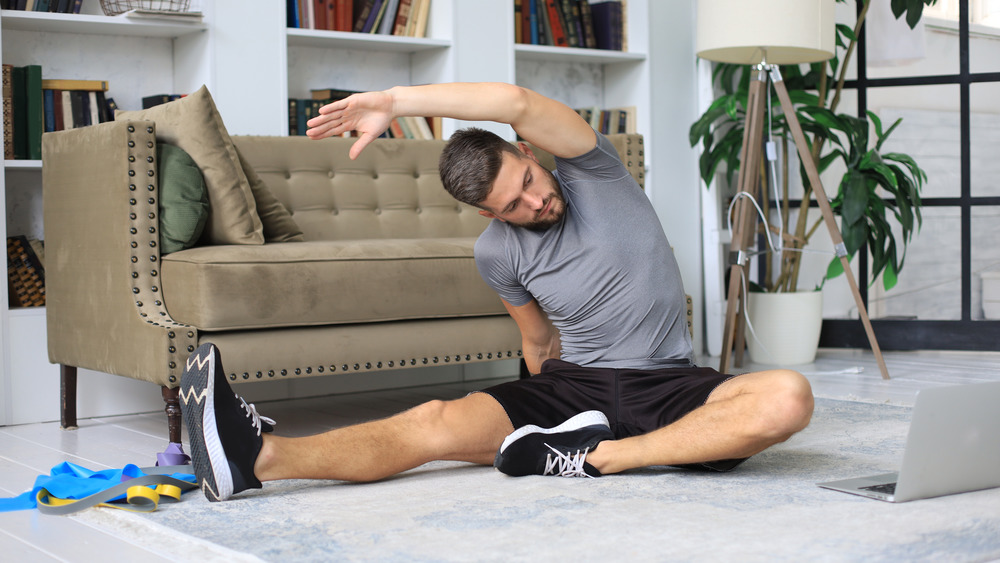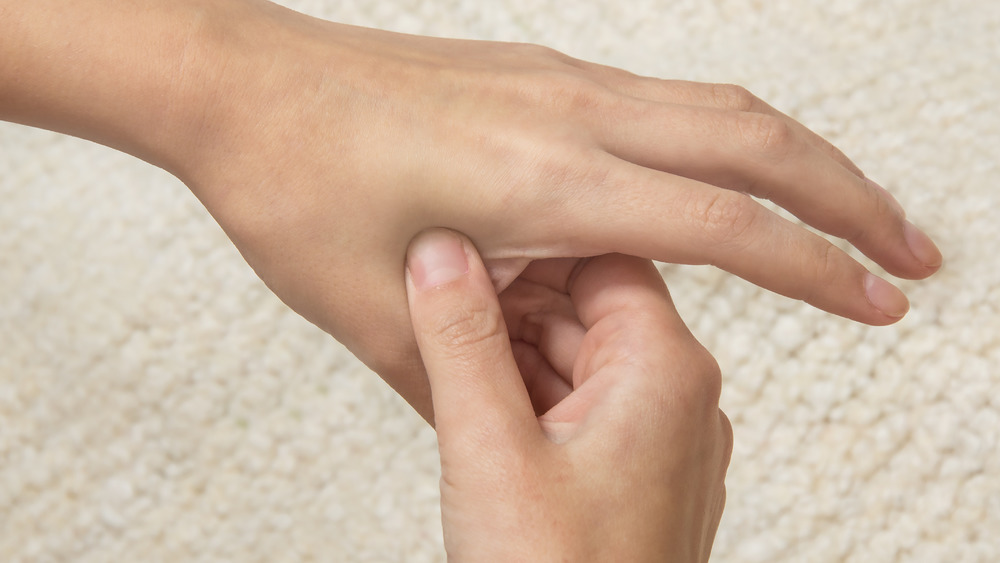Tricks You Need To Try To Get Rid Of Headaches
Headaches are one of the most common and prevalent disorders on the planet, affecting at least half the globe's population, according to the World Health Organization. Headaches can have many causes: illness, stress, alcohol, posture, vision problems, diet, allergies, dehydration, and more. And the triggers and severity of pain are different for everyone. Even worse, once you start getting headaches, you're likely to keep getting them. According to the American Migraine Foundation, "the more headaches you have, the more headaches you may get."
Headaches also vary incredibly, the group said. There are severe headaches known as migraines, cluster headaches, sinus headaches, ice pick headaches that come with stabbing pain, and more. While over-the-counter medications like aspirin and ibuprofen are cheap and effective methods for getting rid of headaches, there are also a number of home remedies that can help to relieve or eliminate headache pain as well. So if you're sensitive to medications, don't have them available, or are simply looking for an alternative way to deal with your headache pain, the strategies that follow are all worth a try.
Try drinking a tall glass of water to get rid of your headache
Being dehydrated doesn't just leave you with a dry mouth. It's also a very common cause of headaches — a logical outcome since our bodies are more than 60 percent water (via United States Geological Survey). According to the folks behind the popular headache medication Excedrin, lack of necessary fluids in the body — whether it's from diet, exercise, or even illness — can cause painful headaches and migraines. You can usually detect a dehydration headache because the pain will be present on all sides of the head, and you won't feel any pressure, per the company.
"As your body becomes dehydrated, the blood vessels of your brain narrow in an attempt to conserve water," physician Carrie Lam told Insider. You don't even have to be that dehydrated for headaches to occur. In a study published in the aptly named journal Headache, U.K. researchers reported water deprivation can indeed trigger headaches.
For an easy trick to track how much water you should be drinking daily, divide your weight in half. That number, in ounces, is the amount to shoot for, experts told Insider.
A hot or cold compress could help you banish a painful headache
Compresses are one of the oldest and most basic remedies around — and they're also still among the most effective. MedicineNet defines a compress as a "cloth or another material applied under pressure to an area of the skin and held in place for a period of time." The cloth can be dry or wet, warm or cold.
Compresses are one of the most simple and effective treatments for various types of headaches. "In general," the National Headache Foundation stated, "most sufferers with migraine headache prefer cold packs. Sufferers with tension-type or muscle contraction headaches may prefer warm packs." Treatment can vary based on the individual and what seems to work best, as headaches remedies work differently from person to person, the foundation added.
Where you place the compress also depends on the temperature of the compress you're using. Cold packs work better on the forehead and temples, while warmer packs tend to be more effective when placed on the back of the head or neck.
A good self massage could help to alleviate a stubborn headache
Headaches come in a variety of forms, but the U.S. National Library of Medicine's Medline Plus revealed that tension headaches — characterized by pain that spreads across your head, scalp, neck, or shoulders — are the type of headache people suffer from most frequently. These headaches occur when "neck and scalp muscles become tense or contract" and can be caused by injuries, anxiety, stress, or depression, according to the publication.
While over-the-counter pain relievers generally help to relieve tension headaches so, too, can a good massage. "Activating trigger points on the face, neck, and head can help redirect and reduce head pain, while stimulating reflexive points on the feet has an overall body-harmonizing effect," massage therapist Heidi Frederick told Goop. Frederick recommends battling your headache by first soaking and massaging your feet, then kneading the area above the ears for around a minute, squeezing and relaxing every muscle in your face, massaging the ears by pulling on them and then working your jaw muscles firmly with your fingers.
For faster relief, physical therapist David Reavy told Prevention to massage your masseter muscle, which is the spot where your cheek and jawbone meet, while opening and closing your mouth. In just 10 seconds, you can find relief from your tension headache.
Cut back on the coffee slowly to alleviate caffeine withdrawal headaches
If you regularly drink large amounts of caffeinated coffee, tea, soda, or energy drinks, missing your favorite beverage can cause your body to revolt, triggering an incredibly painful withdrawal headache. As Self reported, caffeine ramps your body up by keeping your brain from responding to adenosine, a chemical in your brain, that accumulates in your head throughout the day.
This chemical makes you tired so, in small doses, blocking them can pep you up. But neurologist Lauren Green told the magazine that you actually develop more adenosine receptors with increased caffeine intake. Over time, they'll become less sensitive to your high caffeine intake and, as Self explained, "this means that over time you need to ingest more caffeine in order to block adenosine's fatigue-inducing effects, so you form a dependence of sorts."
Once you're dependent on caffeine and miss your regularly schedule cup of joe, you'll experience a painful, throbbing headache. If you believe your headaches are triggered by caffeine, the American Migraine Foundation cautioned you shouldn't immediately give up caffeinated beverages up — something they call "a surefire recipe for more head pain." Instead, break away from caffeine slowly, cutting your intake back by about 25 percent each week — a slow enough adjustment to help you avoid withdrawal symptoms.
Eliminating problem foods from your diet could help to eliminate headaches
An estimated 20 percent of all people suffer from some form of food intolerance and one in four people suffer from food allergies — and these allergies and sensitivities may be a leading cause of headaches for many people as well (via Harvard University). In a paper detailing the phenomenon, postdoctoral researcher Amy Sutton explained that a number of foods including wine, chocolate, aged cheese, high-fat foods, foods containing wheat (gluten), dairy products, processed meats, and bananas are all commonly considered potential headache triggers.
"Dietary triggers are different for each patient," neurologist Gary Jay told Men's Health. For people who believe their headaches may be a result of foods they are eating, he advised keeping a food diary and recording what you eat. Then, when headaches occur, you can look for potential patterns that might signal what your body is responding negatively to.
"I don't recommend a particular diet to anybody with migraines," Johns Hopkins headache expert B. Lee Peterlin told WebMD. "But if somebody says, 'Anytime I eat Brie cheese I get a migraine,' well then, don't do that."
Increasing your intake of certain vitamins and minerals could help you get rid of headaches
Scientists don't exactly know why but nutritional deficiencies – including low levels of vitamin D and other essential nutrients — have been found to be a trigger for headaches in a number of different individuals (via Keck Medicine of USC).
One of the minerals most often linked to headaches is magnesium. According to WebMD, magnesium to keep blood pressure and blood sugar in check and muscles and nerves working properly. However, according to the site, "People with migraines [often] have lower levels of magnesium than the rest of us." In a review of more than 200 studies published in Headache, Swiss researchers concluded that for those who experience migraines regularly, taking 600 milligrams of magnesium daily may help to reduce headache frequency.
A vitamin that is also often linked to headache prevention is riboflavin, or vitamin B2. MedlinePlus explained, "Taking high-dose riboflavin by mouth seems to reduce the number of migraine headache attacks, by about 2 attacks per month." The site added that pairing riboflavin with other vitamins and minerals has also been shown to help reduce pain levels experienced during a headache.
If your head hurts, try a really hot shower
When a headache hits, a steamy shower may be the perfect way to make it go away, according to Mount Sinai headache expert Mark W. Green. "People who wake up with head pain ... often try to stay in bed and pretend it's not real, or hope that it will go away," he told Time. While that rarely works, Dr. Green said, a hot shower might do the trick.
Temperature therapy is one easy and very successful way to treat headache pain (via Mayo Clinic). Heat can help to relax constricted blood vessels, improving blood flow to the brain. It can also loosen tight muscles that might be triggering your headache. And if your head pain is caused by sinus congestion, a moist, hot shower may relieve those symptoms as well. Additionally, research suggests that the heat released during a shower may stimulate nerves in the brain called thermoreceptors, blocking transmission of pain signals and making a headache seem less severe (via Migraine.com).
Having sex may help you get rid of a headache
Turns out there's a big problem with the famous line, "Not tonight dear, I have a headache." Instead of your headache being a reason to avoid sex, it may now be a reason to have sex.
In a landmark study conducted in Germany and published in the journal Cephalagia, researchers surveyed 1,000 people who regularly suffered from migraines and cluster headaches. The men and women were asked about the frequency and severity of their headaches, as well as any sexual activity they had during those headache bouts. Surprisingly, the researchers found that sexual activity was successful in treating 60 percent of regular migraine sufferers and more than one-third of participants with cluster headaches.
"Our results show that sexual activity during a migraine attack might relieve or even stop an attack in some cases," the researchers wrote (via CBS News). In their own reporting on the research, Women's Health added, "According to the study, you get relief no matter who your partner is, which position you use, or which type of sexual activity you engage in." However, it should be noted that some people experienced worsening headache and migraine pain, so a romp in the hay may not work for everyone.
Try using a neti pot to flush away your sinus headache
Allergies and sinus problems aren't just a nuisance. For many, they're a debilitating ailment, causing facial pain, congestion, and painful headaches (via MarketWatch). According to the Centers for Disease Control and Prevention, nearly 30 million American adults are diagnosed with sinusitis each year.
Luckily, an old remedy for allergy and sinus issues — the neti pot — can help to eliminate these symptoms. While the idea of nasal washes is a concept that dates back thousands of years, neti pots (containers designed to flush debris and mucus from the nasal cavity) are a more modern invention, developed during the 1970s (via Himalayan Institute). And they work!
In a 2016 study published in the Canadian Medical Association Journal, researchers found that regularly flushing the nasal cavities with a saline solution helped to improve sinus symptoms and lead to a reduction in both the frequency and severity of sinus and allergy-related headaches. "In addition to improving sinus symptoms, headaches were reduced, there was less use of over-the-counter remedies, and people also said they were less likely to contact the doctor again for a future attack of sinusitis," the study's lead author Paul Little told CNN Health.
If you want to get rid of headaches, make sure you're getting enough sleep
By not sleeping enough, you could be wreaking all kinds of havoc on your body — including dramatically increasing your risk of headaches. Although sleep requirements can vary by person, the National Sleep Foundation recommends getting seven to nine hours of sleep every night. Instead, nearly a third of us try to squeak by on fewer than six hours of sleep nightly — which is far too little. And that's when headaches and migraines start to occur, since "sleep, mood, and headaches are all controlled by common regions in your brain," explained WebMD.
To improve the quality of your sleep — and reduce your risk for all types of headaches — the Mayo Clinic suggests that in addition to simply making sure you get enough sleep, you also set regular sleep hours when you go to bed and wake up each day. Yes, that includes weekends. When it's time for bed, try relaxing with music, a warm bath, or a good book, and steer clear of sleep disrupters such as cigarettes, heavy meals, intense exercise, television, and cell phones, the Mayo Clinic recommended. Use your time for resting instead, and your headaches should subside.
Deep breathing techniques can help to ease headaches
Whether it's crying babies, honking horns, or an insufferable boss, life is full of things that can stress you out. And when you're stressed, your muscles tighten and your blood vessels dilate, increasing blood flow to the brain, according to the American Psychological Association. It's the perfect recipe for tension headaches.
According to Prevention, tension headaches typically last a half-hour or longer with symptoms including a dull ache, pressure throughout the head, or pain in the scalp, temples, or the back of the neck. One of the best ways to beat tension headaches is with deep breathing — slow, rhythmic, controlled inhaling and exhaling — a process which loosens tight muscles and increases the flow of oxygen to the brain, per the American Migraine Foundation.
Although there are numerous breathing exercises out there, Harvard experts suggest starting with a process called "breath focus." It's easy. After finding a quiet comfortable place to sit or lie down, take a normal breath followed by a deep breath. "Breathe in slowly through your nose, allowing your chest and lower belly to rise as you fill your lungs," the medical school advised. Then, exhale slowly through your mouth. Repeat as needed until you feel calmer and your headache subsides.
Try yoga or stretching to get rid of a stubborn headache
Instead of immediately reaching for an over-the-counter pain reliever when a headache strikes, WebMD recommended something far more counterintuitive: exercise — specifically yoga or stretching. Headache specialist Merle Diamond told the site, "[Yoga] helps you stretch and unwind your body, improve your posture, and breathe more slowly — all things that can help reduce a headache."
When it comes to the stretches that work best for getting rid of headaches, Health suggests shoulder shrugs (move your shoulders up, up and forward, and then up and back) and neck isometric stretches, in which you press your palm against your forehead or the left or right side of your head and resist with your neck muscles.
Another great option, according to AmeriCare Physical Therapy, is chin tucks. To perform them, sit all the way back in a tall chair with your back firmly against the backrest. Then "bring your chin towards the front of your throat without tilting the head," physical therapist Laura Wong advised. She went on to compare the move to trying to "give yourself a double chin without tilting the skull down." Hold the stretch for five seconds, relax, and repeat as needed.
Consider using acupressure to relieve headache pain
Although it may sound new agey, acupressure — which is similar to acupuncture but without the needles — has been used in traditional Chinese medicine for many centuries. According to Real Simple, the concept centers around the way energy, or qi, circulates in your body. When qi is blocked, practitioners believe, pain and sickness — including headaches — can occur. They also believe pressure points all over the body can help to ease these blockages, allowing your qi to flow properly and helping ailments to go away.
One powerful acupressure point thought to eliminate headaches is what's known as the "third eye"—the area directly between your eyebrows. To stimulate it, try "applying constant pressure or gently massaging in a circular motion," advised Medical News Today. Another powerful pressure point to consider stimulating, according to Memorial Sloan Kettering, is the bit of fleshy tissue located between the base of your thumb and your index finger. You'll want to press down on the area moving your thumb in a circular motion for up to five minutes. "Be firm, but don't press so hard that it hurts," the hospital advised. When you finish, repeat on your other hand.
Visualizing your headache sounds strange, but it could help ease your pain
An alternative pain relief technique that may just help to rid you of a headache is visualization, according to Harvard Women's Health Watch. "Mind-body approaches may provide relief, but they haven't been adequately tested in controlled clinical trials and may not be covered by insurance," the publication explained. However, these techniques appear to work for some people, as a study in Cephalalgia showed. Visualization meditation may even be able to help treat migraines, according to Headspace.
One common evidence-based visualization technique involves picturing "packing up your pain" into large wooden crates that you then imagine loading onto a ship. After which, you then sail them out to sea (Migraine Again). Additionally, Harvard Women's Health Watch suggested a technique: "Find a quiet, comfortable space, close your eyes and concentrate on your headache. Try to determine its size and shape. Once you have visualized it, imagine it becoming fainter and smaller until it eventually disappears."

